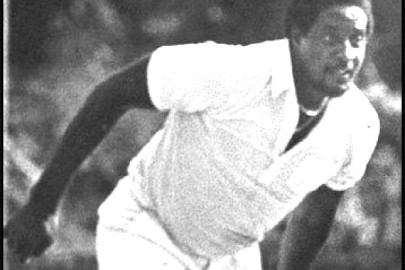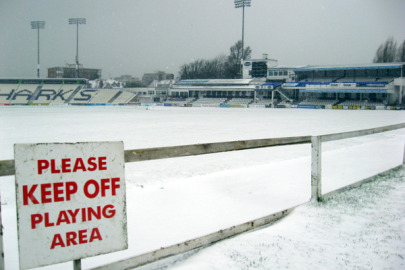Jon Hotten discovers that Australian cricket legend Jeff Thomson – one of the most dangerous fast bowlers of all time – still knows the right way to tell a story…
It was a few hours after David Warner had taken a swing at Joe Root in a Birmingham bar, and Jeff Thomson was standing in a marquee full of people with a microphone in his hand. We were there to play six a side cricket, but the rain was coming down and the buffet was excellent, so Thommo had a full house.
He was wearing the hooray uniform of red jeans and a blue blazer; set upon his broad shoulders and pipecleaner legs it made him look like the kind of guy who joins a soap opera and makes off with the unsuspecting widow’s money.
Next to Thommo was David Steele, the bank clerk who went to war and spent consecutive summers defying the pace attacks of Australia and West Indies. They fell quickly into type. Thommo stood with one hand in the pocket of his red jeans looking out across the room, while Steele managed to turn off two microphones as he was talking; interrupting his own gentle anecdotes about getting lost in the Lord’s Pavilion, and being paid in lamb chops for every run he scored by a local butcher.
Thommo by contrast told a single story (‘I haven’t done this one for a while…’ ) which was about the dismissal of Keith Fletcher at Sydney in 1975.
‘Me and Dennis had a plan,’ he began, ‘which was to kill the pricks. A couple of them had already gone to the hospital. A wicket goes down and out comes this little prick Fletcher (‘prick’, it quickly became apparent, was a term of some endearment to Thommo, and he used it gently, almost with fondness). ‘Now the Pavilion at Sydney is at square leg and Dennis is fielding at third man. I’m at the end of my run and I’m ready to kill the prick you know. But Dennis comes running over from third man all the way to square leg and starts abusing Fletcher. I’m getting mad with Dennis because I’m ready you know. I’m warm and it’s coming out well….’
‘Then Dennis comes running over to me. ‘I’m like, yeah Dennis, I know the plan. Kill him…’
‘Yeah,’ says Dennis. ‘But I really want you to kill this little prick…’ Then he ran back down to third man. Anyway, first ball, too high. Next ball, adjust the radar… bang… hits him right in the middle of the forehead. Absolutely smack in the middle. I go down to have a look at him and he’s got the most perfect six stitch-marks…’
Thommo pointed to the spot on his own forehead, and paused for a second, a faraway look in his eyes. He was transporting himself. ‘The physio comes on, Bernie Thomas he was called. Fletcher’s staggering all over the place, he can’t see straight. Someone says, ‘He’ll have to go off…’ and Bernie says, ‘he can’t we’ve already got two in the hospital…’ So Bernie pushes him back to the crease…’
He mimed Bernie Thomas positioning Fletcher into his stance. By now, Thommo was wiping tears of mirth from his eyes. Everyone in the tent was enjoying the story, and more than that, they were enjoying Thommo’s enjoyment of it. He paused.
‘So I go back…’ He wiped his eyes again. ‘I go back and you know next ball, BLAM, stumps all over the place. ‘Off you go you little prick…’ I’m saying, and then, here comes Dennis, all the way back up from third man, just to abuse him again as he goes off…’
By now, Thommo was rocking back on his heels and dabbing at his eyes. ‘Ah bloody hell…’ he said. ‘That’s what happened, straight up. I haven’t told that one for a while, I really haven’t.’
He and Steele were applauded warmly as they returned to their seats, and Thommo was an equitable presence for the rest of the afternoon. Once the rain had blown through, he stood on the boundary holding a bottle of beer, talking to his mates and having his picture taken. During the talk, David Steele had said: ‘I liked facing fast bowling, I liked the challenge of it. Let me tell you, I faced them all, and this man Jeff Thomson was the quickest.’
I thought about that as I watched Thommo. He represented something: a game and a country now gone but sweet in the memory. Had the incident with Fletcher happened that day on the ground right in front of us, it would have been impossible to describe it as he had done. It was only funny now, all of this time later, when the blood and the battle had receded.
I wanted to find out how true Thommo’s story was, so I looked up the game on cricinfo. There it was, Test match number 751, Australia versus England at the SCG, fourth Test, 4-9 January 1975. Australia won by 175 runs, JR Thomson 4-74 and then, coincidentally, 2-74 in the second innings.
The Almanack reported: ‘On the last day the demoralising effect of Thomson and Lillee was never more apparent. From 68 for no wicket in the 16th over, the score became 74 for three in the 22nd with Edrich on his way to hospital after being hit below the rib-cage first ball by a Lillee skidder…’
Yet the pitch was slow, and batting easy enough for Bob Willis to survive for 88 minutes, and Geoff Arnold 35; the Almanack left its readers in no doubt that more application was required from England’s batsmen.
Then there was this: ‘Only Amiss, caught off his gloves off a bouncer that cut back, and Fletcher, shaken by a deflection on to his forehead two balls before his dismissal by Thomson, were exempt from blame.’
Fletcher had made 11, and rather than being bowled, he’d been caught be Ian Redpath. Maybe Thommo had forgotten that detail, and maybe he hadn’t. He remembered the story, though, and he knew how he should tell it: as it was in his head rather than in the record books.
Thommo exists in both places, as cricketer and as myth. His era has settled in the collective mind as a raw and unforgiving time when the game was wild, on and off the field. David Warner’s half-hearted swing at Joe Root and the endless round of media statements and public apologies later, confirmed the distance between here and there. Maybe one day Warner will be telling the story and everyone will be laughing and living and thinking of the years that have passed.












I find all that sledgey stuff kind of gauche I must say
Apparently the Aussie cricketers divide into two camps: Nerds (hard as nails, chippy, gauche, Pom-eating, crocodile-wrestling) and Julios (bleach-blonde earring-wearing fashion-victims) – and the chief reason for their current malaise is that there are too few Nerds and too many Julios.
There are some excellent Thommo vids on youtube, such as this one.
So much for the spirit of cricket. As Wisden put it: ‘Never in 93 years of Test cricket have batsmen been so grievously bruised and battered by ferocious, hostile, short-pitched balls.’ But Thommo’s physical and mental assault on England’s batsmen in 74/75 in partnership with the far greater, but equally unpleasant, Lillee, wasn’t going to stop me, only a few months later, sitting for hours in one of Old Trafford’s dilapidated old stands, with the wind funnelling through a smashed window pane and down the back of my neck, waiting hour after hour for the rain to stop to give me at least a few overs in the company of the brothers grim. My expectations of watching lightening fast bowling, the fastest since Tyson was in his short-lived pomp, failed to recognise that this was Manchester in July; not Perth in December; Lancashire CCC not England; 15 degrees, not 32. Lillee and Thomson went through the motions; match drawn. For all his nastiness, real or feigned, I was genuinely sorry when Thomson was badly injured in an on-field collision with a teammate in 1976, resulting in a dislocation of the right collarbone, and the end of his ability to bowl at the speed of light. The sight of the truly fast bowler operating at the peak of his powers is one of the most compelling reasons to watch cricket.
A year later at the Old Trafford Test between England and West Indies, I sat, open-mouthed, on a late Saturday afternoon, as Michael Holding launched a frightening assault on 45 year old Brian Close and 39 year old John Edrich. I’d never seen bowling so fast and hostile, but then I never saw Tyson. How one of those old blokes wasn’t killed or maimed will remain a mystery. Holding, unlike Thomson, has never stated, as far as I know, that he set out to hurt England’s batsmen, Intimidate? Yes, Hurt? No. I’ve always hoped that was the case. Perhaps Close, with his ‘fuck you’ demeanor was the red flag to that particular bull? After the Oval Test of that summer during which Holding took 14 wickets, Tony Greig, who had faced Thomson and Lillee in the 74/75 series, said of Holding: ‘It was the greatest performance I have ever seen by a fast bowler. I do not believe there can ever have been a faster bowler than Holding. On the two occasions in this series when he has been fully fit he was faster than the Australians.’ As Ralph Barker states in his ‘Innings of a Lifetime’ (the innings under scrutiny was that played by Dennis Amiss in that Oval Test): ‘Against Mike Denness’s team (74/75) Lillee and Thomson were helped by fiery wickets of uneven bounce. But Holding succeeded on a dead, much maligned pitch on which his pace was so disconcerting that batsmen were glad to get down the other end to face Roberts, one of the greatest bowlers of the day.’
Ah, cricket, lovely cricket! Roll on the Ashes! Perhaps the Aussies should recall Lillee and Thomson.
Nobody has been killed in major league baseball by a pitched ball since batting helmets came into use, but some players (Tony Conigliaro, for example) have had their careers shortened.
Baseball has a whole unwritten code around hitting the batter. A player who preen his away around the bases after a home run may get knocked down in his next at-bat. Knocking down a batter for no good reason may get a pitcher or (especially in the American League) a teammate knocked down. An egregious case may find a large angry man charging the pitcher with his bat up. Or a repeat offender may get run over when somebody bunts and he has to cover first base.
A cricket bat does not look quite as lethal, but I shouldn’t care to be struck with one. Do matters ever come to that in cricket?